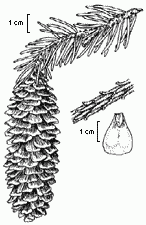
Foliage, cone, twig and seed [L.A. Vorobik] (5).
Common Names
Weeping or Brewer's spruce (2).Taxonomic notes
This spruce is a local endemic with no close relatives. Possibly the closest is the European endemic P. omorika , which has some similarities in foliage, and possible hybrids (unverified) have been observed in cultivation in Britain. Syn: P. brewerana .Description
"Trees to 40 m; trunk to 150 cm diam., typically buttressed; crown conic. Bark gray to brown. Branches drooping; twigs pendent, elongate, slender, gray-brown, finely pubescent. Buds gray-brown, 5-7 mm, apex rounded. Leaves 1.5-3 cm, flattened or broadly triangular in cross section (abaxial surface rounded or slightly angular), rather rigid, abaxial surface dark green with stomatal bands absent, adaxial surface glaucous with conspicuous stomatal bands separated by slight ridge or angle, apex blunt (especially on older leaves)." Seed cones dark red-purple ripening red-brown, cylindrical, 6.5-12 (-14) cm; scales fan-shaped, 15-20 × 15-20 mm, rigid, margin at apex entire to slightly erose (3).Leaves radial all around pendulous shoots, somewhat flattened down onto level shoots; pendulous shoots tend to have longer leaves (2-3 cm) than level shoots (1.5-2.5 cm). Young trees do not show pendulous branchlets until about 10-20 years old, and until then are open with level shoots and shorter leaves (1.5-2 cm); they can be confused with Picea omorika at this age.
Range
USA: SW Oregon and NW California at 1000-2300 m in montane to subalpine forests of the Siskiyou Mountains (1, 3). See also (8). USDA hardiness zone 6.Big Tree
Height 54 m, dbh 163 cm, crown spread 17 m, in Trinity Alps Wilderness, CA (6).Oldest
Dendrochronology
Ethnobotany
Observations
It is most easily seen in the wild at Castle Crags State Park, CA (4).Remarks
Although of limited distribution, the species is listed by the WCMC as low risk, not threatened because it is not exploited for timber and a significant fraction of its range is formally protected, e.g. within the Siskiyou Wilderness (7).A highly ornamental species, with long curtains of strikingly pendulous branchlets from upswept or level branches, but slow growing and difficult to establish in cultivation. It is highly prized in British horticulture, but its low climatic tolerance greatly restricts the regions in the USA which it can be grown successfully.
Citations
(1) Silba 1986 .(2) Peattie 1950 .
(3) Taylor, Ronald J. at the Flora of North America web site .
(4) Vladimir Dinets, e-mail communication, 10-Jan-1998.
(5) Hickman 1993 .
(6) American Forests 1996 .
(7) World Conservation Monitoring Centre - Trees .
(8) Robert S. Thompson, Katherine H. Anderson and Patrick J. Bartlein. 1999. Atlas of Relations Between Climatic Parameters and Distributions of Important Trees and Shrubs in North America. U.S. Geological Survey Professional Paper 1650 A&B. URL= http://greenwood.cr.usgs.gov/pub/ppapers/p1650-a/pages/conifers.html , accessed 22-Jan-2000.
See also:
Burns & Honkala 1990
.
Farjon 1990
.
FEIS database
.
Waring, R.H., W.H. Emmingham, and S.W. Running. 1975. Environmental limits of
an endemic spruce,
Picea breweriana. Canadian Journal of Botany
53: 1599-1613.
This page co-edited with Michael P. Frankis, Dec-1998.
[ Picea ] [ Pinaceae ] [ home ]
This page is from the Gymnosperm Database
URL: http://www.geocities.com/RainForest/Canopy/2285/pi/pic/breweriana.htm
Edited by Christopher J. Earle
E-mail:
earlecj@earthlink.com
Last modified on 24-Jan-2000